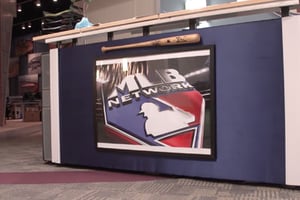
Big Leagues, Big Demands
When we watch a baseball game from our couches at home, we are usually focused on strikes, outs, home runs and maybe even snacks. The farthest thing from our minds is the massive production that makes live broadcast delivery possible.
But MLB Network does even more than just live broadcast. The network brings together multiple live feeds from each of Major League Baseball’s 30 ballparks, using the streams to provide on-air content for live broadcasts, on-demand video, archiving, and storage for later use.
A while ago, MLB Network realized that its data infrastructure and bandwidth capabilities were getting stretched too thin. Given its growing data demands and its limited on-site processing and storage capacity, the company faced a crossroads: build and manage a new data center on its own, or find an offsite partner capable of meeting the stringent requirements of a broadcasting operation.
"Our challenge was unique in that we were dealing with content that needed to be edited to support live television rather than pre-recorded broadcasts,” says Tab Butler, Director of Media Management and Post Production at MLB Network. “We needed a non-conventional approach to expanding our data center capabilities without losing any of the speed and reliability."
Butler knew what it would cost—in time and money—to expand the network’s data center operations and manage them internally. But the picture for outsourcing it wasn’t as clear.
“As costly and resource-intensive as building out a new data center can be, it appeared to be our only viable option.”
Since its business was built around rapid processing and distribution of video and audio content, the network needed a low-latency facility capable of running in parallel with its on-site operations and supporting its planned growth. Most importantly, however, MLB Network needed assurances it could remain on-air without fail, requiring comprehensive disaster recovery capabilities.
Butler engaged with a number of data center providers near the network’s headquarters. After significant planning, analysis, and comparison, MLB Network finally found a data center that met their stringent needs: CoreSite’s NY2 facility.
“We had the full force and support of the entire CoreSite team at our disposal and the whole experience was flawless.” Tab Butler, Director of Media Management and Post Production, MLB Network Butler says. “In the broadcast industry, the ability to stay on the air no matter the situation is paramount to our success. To meet each of our business requirements, a vendor partner would have to be local, have a dense and scalable network environment, and be well equipped to handle all our disaster recovery needs. That’s a lot to ask.”
CoreSite’s data center provides the latest in power, cooling and networking technologies to efficiently and cost effectively run the network’s parallel operations. The data center features hard-wired cross connections for rapid spin up of new servers that support content packaging and is connected with MLB Network’s primary location via redundant dark fiber connections for lightning-fast content delivery and failover protection. When they’re not working directly from the cage, Butler’s team can be productive in their spacious private offices rented from CoreSite and rely on Remote Hands services to keep an on-site presence at all times, just like in the home office.
Even with all the space and industry leading technologies in the data center, it was Butler’s experience interacting with the CoreSite account team that left the biggest impression. Unlike data center providers that offer predetermined services, CoreSite can customize solutions to meet even the most unique business demands.
“Working with CoreSite has enabled us to accomplish goals that we did not necessarily feel were realistic two years ago,” he says. “The relationship has opened a world of new opportunities for us and I can’t overstate how excited we are to continue the partnership in the future.”








